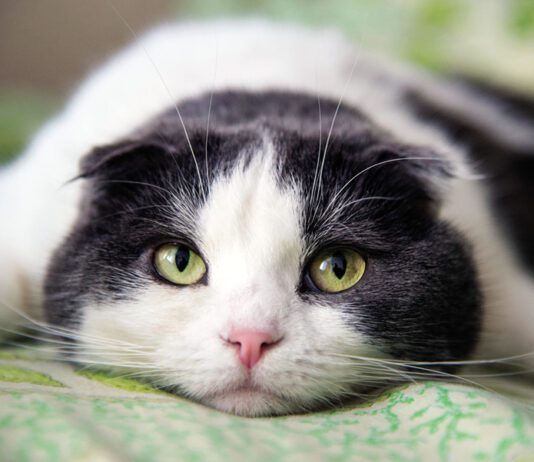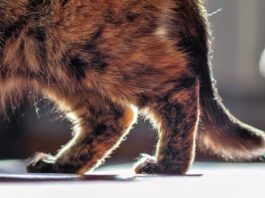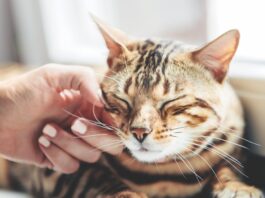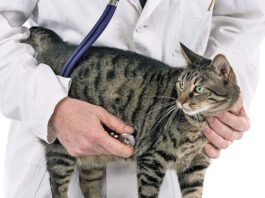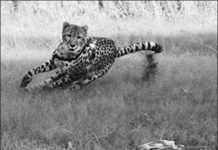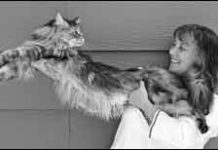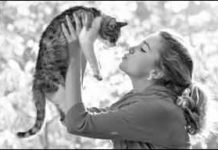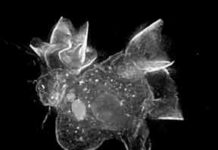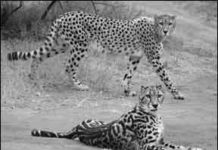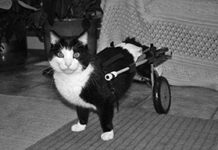Unwelcome Petting Can
Cause Stress, a Study SaysThis will come as a shock to owners who enjoy petting their cats. Some cats like being petted and purr in delight; others only tolerate it. In fact, according to a study by an international team of animal behaviorists, when owners impose themselves on cats to pet them, the cats experience stress and release hormones linked to anxiety.
The Message Worth Repeating: Leave No Pet Behind in a Disaster
At one point when rushing rivers flooded Colorado towns and farms earlier this year, 2,000 stranded people and 500 pets were evacuated by helicopter. The swift, rising water caused loss of life and damage to 2,380 acres in the state. The American Humane Association and other organizations on the ground rescued hundreds of pets and livestock.
58 MPH Sounds Fast, but Grip and Maneuverability Play Key Roles
Cheetahs, our domestic cats’ big cousins, seem to fascinate scientists. Maybe it’s because they’re the fastest land animal, and measuring their speed presents a challenge. Researchers have clocked cheetahs running after a lure and observed films of them chasing prey in the wild.
Short Takes: September 2013
The sad truth about cats’ access to veterinary care in the U.S.: They don’t have much. Surveys show that nearly twice as many dogs visit the veterinarian as cats, even though the cats outnumber dogs — 86 million versus 78 million. Thirty-nine percent of owners say they would take their cat to the veterinarian only in the event of illness; and 60 percent report that their cat hates going to the veterinary clinic. The visits may stress both owners and cats, says the American Association of Feline Practitioners. To offer a more calming, encouraging environment, it has launched an initiative to improve cats’ treatment, handling and overall health.
A Single Gene Keeps Mice Away From Cats
A specific gene affecting a mouse’s sense of smell helps it avoid predatory cats, according to research at Northwestern University. Neurobiologist Thomas Bozza, Ph.D., and his team found that removing an olfactory receptor responsible for detecting certain odors can impact a mouse’s survival. The gene, TAAR4, controls production of a receptor that detects a substance concentrated in carnivores’ urine. Usually, mice avoid the scent marks of predators, but those lacking the TAAR4 gene do not — and can end up as prey.
Singles Turn to Pets for a Sense of Family
An intriguing trend has developed among singles in the U.S. Single people — men particularly — are becoming pet owners at rates greater than families. They’re “turning to pets for love and a sense of family,” according to a survey by the American Veterinary Medical Association. In a five-year period, pet ownership among the never married, widowed and divorced grew 16.6 percent. Excluding people who never married, growth in pet ownership among singles rose 17.7 percent during this same period.
Short Takes: June 2013
Obesity among pets in the U.S. continued to climb in 2012, with the number of overweight cats reaching an all-time high. Veterinarians reported that 58.3 percent of their feline patients — up from 55 percent over the previous year — were overweight or obese in the sixth annual survey by the Association for Pet Obesity Prevention (APOP). Given the cat population of 74.1 million in this country, that equals about 43.2 million cats, the association says. Surprisingly, the survey also revealed a “fat gap,” according to APOP founder Ernie Ward, DVM. When veterinarians asked owners to describe their fat cats’ body condition as too thin, normal, overweight or obese, 45.3 percent said normal.
Short Takes: May 2013
A study published earlier this year that estimated free-ranging domestic cats annually kill up to 3.7 billion birds and 20.7 billion mammals has stirred controversy and brought renewed calls for action.The study’s three authors from migratory bird centers at the Smithsonian Conservation Biology Institute and U.S. Fish and Wildlife Service conducted a “systematic review and quantitative estimate of mortality.” They say “unowned cats,” as opposed to owned pets, cause the majority of the deaths.
Short Takes: April 2013
A survey of more than 50,000 U.S. households has uncovered a puzzling disconnect between cat owners’ beliefs and actions. Owners in 2011 said they increasingly consider their cats family members — 56 percent, up from 49.4 percent in 2006. Yet just 27.1 percent of owners say they took their cats to the veterinarian only when they were sick. Given that the feline population in the U.S. is approximately 74.1 million, about 20 million pet cats went without regular checkups and care in 2011.
Tracking a Parasite as it Invades the Brain
It’s common knowledge that pregnant women should avoid litter boxes to avoid contact with toxoplasma. The parasite found in cat feces can cause toxoplasmosis, a disease that may cause a number of developmental abnormalities in developing fetuses and neurologic, ocular and other potentially severe problems in people with compromised immune systems. Research in recent years has shown an association between toxoplasmosis and schizophrenia, depression and anxiety. Studies also suggest that the disease can influence levels of human aggression, extroversion and risk-taking. Now a study by the Karolinska Institute in Sweden suggests a mechanism by which toxoplasma may influence the behavior of its hosts.
How did the tabby and cheetah get their stripes?
Researchers gathered DNA and tissue samples from feral cats in Northern California. They also studied skin biopsies and blood samples from captive and wild South African and Namibian cheetahs, and in a study believed to the first to identify a molecular basis of coat pattering in mammals, they made this discovery: Tabby cats and rare king cheetahs share a gene responsible for the cats’ stripes and the cheetahs’ spots. However, when a mutation occurs, the tabby will develop patches of color rather than stripes, and the cheetah’s spots and blotches turn into wide stripes down its back.
Short Takes: January 2013
A Husky found the kitten lying in the street and gently carried him in his mouth home to his owner. Scooter had a broken spine and his back legs were paralyzed. Euthanasia would have been the likely fate for a kitten in similar shape. But Betsy Kennon, VMD, at Harts Run Veterinary Hospital in Fox Chapel, Pa., was determined to save his life — and she did. Hospital clients chipped in to buy Scooter a custom-made wheeled cart to get around.

